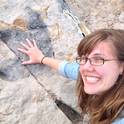- Blastozoa,
- crinoid,
- Eumorphocystis,
- echinoderm,
- homology,
- evolution
Recent debates over the evolutionary relationships of early echinoderms have relied heavily on morphological evidence from the feeding ambulacral system. Eumorphocystis, a Late Ordovician diploporitan, has been a focus in these debates because it bears ambulacral features that show strong morphological similarity to early crinoid arms. Undescribed and well‐preserved specimens of Eumorphocystis from the Bromide Formation (Oklahoma, USA) provide new data illustrating that composite arms supported by a radial plate that bear a triserial arrangement of axial and extraxial components encasing a coelomic extension can also be found in blastozoans. Previous reports have considered these arm structures to be restricted to crinoids; these combined features have not been previously observed in blastozoan echinoderms. Phylogenetic analyses suggest that Eumorphocystis and crinoids are sister taxa and that shared derived features of these taxa are homologous. The evidence from the arms of Eumorphocystis suggests that crinoid arms were derived from a specialized blastozoan ambulacral system that lost feeding brachioles and strongly suggests that crinoids are nested within blastozoans.
Palaeontology, v. 62, issue 1, p. 163-173
Available at: http://works.bepress.com/sarah-sheffield/11/
